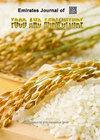Comparison of cotton (Gossypium hirsutum) hybrids and their non-transgenic in India
IF 0.7
4区 农林科学
Q3 AGRONOMY
引用次数: 0
Abstract
It is still not clear whether differential response of Bt cotton and conventional non-Bt cotton genotypes in terms of growth, phenology and yield ability are hypothetical or realistic. This study investigated the response of three Bt cotton hybrids in comparison to their conventional non-transgenic version (near-isogenic lines) along with two locally adapted genotypes for growth, yield attributes, phenological characteristics and rooting behavior. Therefore, two experiments were conducted during summer season of year 2016 and 2017 to evaluate differences among 3 popular Bt cotton hybrids along with their non-Bt version. First field experiment was conducted as a pot study wherein shoot and root parameters of 3 Bt cotton hybrids (Ankur 3028, MRC 7017, Bioseed 6588) were compared with their non-Bt version along with 2 local checks (i.e.,hirsutum cotton Cv. F2228 and arboreum cottonCv. FDK124). Second field experiment evaluated growth, phenological characteristics, yield attributes and productivity potential of above mentioned Bt and non-Bt hybrids. Findings of pot experiment could not establish any significant difference among studied Bt and non-Bt hybrids for root and shoot characteristics. However, arboreum cotton FDK124 exhibited higher root length than all genotypes. Results of second experiment revealed significant differences for phenological characteristics, wherein Bt version of all the tested hybrids exhibited earliness for flowering initiation, 50 % flowering and days to maturity over their non-Bt version. Seed cotton yield (SCY) in all hybrids possessing Bt gene was significantly higher than their non-Bt version primarily due to higher bolls plant-1. Studies conclude that introgression of Bt gene could not alter rooting parameters of evaluated cotton genotypes but significantly affected phenological stages by inducing earliness and higher SCY in Bt versions due to improved bolls plant-1. Keywords: Bt cotton; Near-isogenic lines; Phenology; Root dry matter; Seed cotton yield印度棉花(Gossypium hirsutum)杂种及其非转基因品种的比较
目前尚不清楚Bt棉花和传统非Bt棉花基因型在生长、表型和产量方面的差异反应是假设的还是现实的。本研究调查了三个Bt棉杂交种与其传统的非转基因版本(近等基因系)以及两个局部适应的基因型在生长、产量属性、表型特征和生根行为方面的反应。因此,在2016年和2017年夏季进行了两项实验,以评估3种流行的Bt棉花杂交种及其非Bt版本之间的差异。第一个田间试验是作为盆栽研究进行的,其中将3个Bt棉杂交种(Ankur 3028,MRC 7017,Bioseed 6588)的地上部和根部参数与它们的非Bt版本以及2个局部对照(即,长毛棉Cv.F2228和树棉Cv.FDK124)进行了比较。第二个田间试验评价了上述Bt和非Bt杂交种的生长、酚学特性、产量特性和生产力潜力。盆栽试验结果表明,Bt和非Bt杂交种在根系和地上部特性上没有显著差异。然而,树生棉FDK124表现出比所有基因型更高的根长。第二个实验的结果显示,在表型特征上存在显著差异,其中所有测试的杂交种的Bt版本都表现出比非Bt版本更早的开花、50%的开花和成熟天数。所有具有Bt基因的杂交种的籽棉产量(SCY)都显著高于非Bt基因杂交种,这主要是由于棉铃株-1较高。研究表明,Bt基因的渗入不会改变所评估的棉花基因型的生根参数,但由于棉铃植株的改良,Bt版本的早熟和SCY较高,从而显著影响了酚期。1.关键词:Bt棉花;近等基因系;表型;根干物质;籽棉产量
本文章由计算机程序翻译,如有差异,请以英文原文为准。
求助全文
约1分钟内获得全文
求助全文
来源期刊

Emirates Journal of Food and Agriculture
AGRONOMYFOOD SCIENCE & TECHNOLOGY&nb-FOOD SCIENCE & TECHNOLOGY
CiteScore
1.80
自引率
0.00%
发文量
18
期刊介绍:
The "Emirates Journal of Food and Agriculture [EJFA]" is a unique, peer-reviewed Journal of Food and Agriculture publishing basic and applied research articles in the field of agricultural and food sciences by the College of Food and Agriculture, United Arab Emirates University, United Arab Emirates.
 求助内容:
求助内容: 应助结果提醒方式:
应助结果提醒方式:


